 Add Panel-to-Panel Embed Assembly ( Modeling )
Add Panel-to-Panel Embed Assembly ( Modeling )
Tool summary :
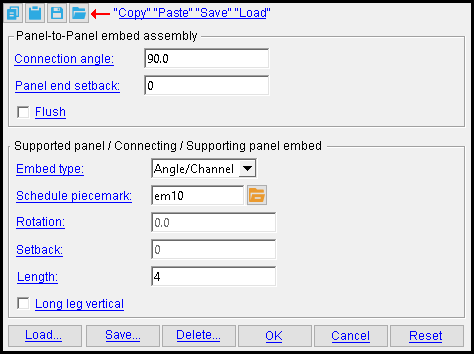
Also see :
| YouTube video: Adding Panel-to-Panel Embed Assemblies |
- Add Embed Assembly (a similar tool)
- Add Panel-to-Footing Embed Assembly (a similar tool)
concrete | the concrete command group in modeling | top
 To add a panel-to-panel embed assembly :
To add a panel-to-panel embed assembly :
1 . Before using this tool, add to the Embed Schedule any plates, angles, or channels that you want to use in the to-be-added embed assembly.
2 . In Modeling , use Snap to Surface or a related tool to go to an elevation view that is parallel with a surface of the tilt-up panel that you will add the embed assembly to.
3 . Invoke Add Panel-to-Panel Embed Assembly . Its icon can be added to your toolbar (classic) or ribbon (lightning). The icon, keyboard shortcut or context menu command can be found in the group named ' Concrete '. For lightning, Customize Interface is used to configure ribbons, keyboards, the context menu, and modes.
4 . The status line prompts, " Locate Tilt-Up Panel ." Select the tilt-up panel that you want to add an assembly to.
5 . Locate- Pan -Return mouse bindings become active. The status line prompts, " Locate reference point. " The point locators On Polygon Line and ANNO becomes active. The point location target (
) appears near the edge of the panel that your mouse pointer (
) is closest to, and moves with it. A dimension annotation indicates the distance that you have moved from the top or bottom of the panel. When you are satisfied with that distance, left-click ( Locate ) to place a reference point. The reference point that you locate will lie at the midpoint of the to-be-added assembly along its length. It also lies along the edge of the tilt-up panel.


bindings 6 . The Panel-to-Panel Embed Assembly window opens.
6a (optional) . Enter a " Connection angle " to match the angle between the supported tilt-up panel and an adjacent supported panel, enter an " Panel setback ," and check or uncheck " Flush ," as required.
6b (optional). " Load " previously saved panel-to-panel embed assemblies.
7 . With the Panel-to-Panel Embed Assembly window still open, choose an " Embed type " and enter other options for the supported, connecting, and supporting panel embeds. If you performed step 6b, you can edit the embed assembly that you loaded.
7 (optional). " Save " the panel-to-panel embed assembly that you edited, if you want add it to other tilt-up panels.
8 . Press " OK " to close the Pad-to-Panel Embed Assembly window.
9 (optional). The status line prompts, " Locate reference point. " Locate-Pan-Return mouse bindings become active. Left-click to place another embed assembly that is identical to the one that you edited in steps 6 - 9. Repeat this step as required.
10 . Right-click to exit the Pad-to-Panel Embed Assembly tool.
9 . If User and Site Options > Modeling > " Automatically process after modeling operation " is set to ' Process and create solids ', the panel-to-panel embed assembly will be generated immediately. If not, the embed will be generated in the tilt-up panel the next time the member undergoes Process and Create Solids .
concrete | the concrete command group in modeling
------ Panel-to-panel embed assembly ------
Connection angle: A positive or negative (-) number of degrees between the supported panel embed and the supporting panel embed. This option does not apply when the supporting panel " Embed Type " is ' None '.
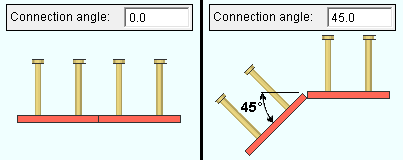
|
A plan view of panel embeds with different " Connection angle " settings |
Tip: To align the supporting embed with the supporting tilt-up panel, enter the number of degrees of the angle between the supported and supporting tilt-up panels.
Panel end setback: The distance (in the primary dimension " Units " or other units ) by which the supporting panel embed is set back from the supported panel embed. This option does not apply when the supporting panel " Embed Type " is ' None '. If the supported or supporting panel has a non-zero entry to " Setback ," that distance is added to the panel end setback when the plate is added.
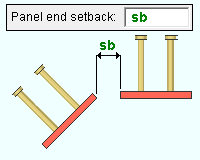
|
A plan view showing the effect of a positive " Panel end setback " on the position of the supported and supporting panel embeds. |
Flush: ![]() or
or ![]() . This option does not apply when the [Connecting embed] " Embed Type " is ' None '.
. This option does not apply when the [Connecting embed] " Embed Type " is ' None '.
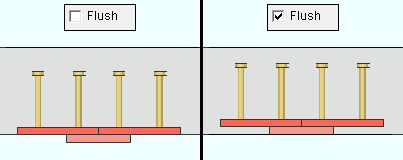
|
A plan view of two embed plates with different " Connection angle " settings. |
If this box is checked (
), " Flush " makes the outermost face of the connecting embed flush with a face of the tilt-up panel.
If the box is not checked (
), " Flush " does not make the outermost face of the connecting embed flush with a face of the tilt-up panel. Instead, when the supported or supporting panel embed type is ' None ', the face of the panel embed is flush with the face of the panel.
concrete | the concrete command group in modeling | top
------ Supported panel embed -----
------ Connecting embed ------
------ Supporting panel embed------
Embed type: None or Plate or Angle/Channel .
' None ' prevents an embed from being generated when the embed assembly is added to the tilt-up panel.
' Plate ' adds an embed plate to the embed assembly. If a " Schedule piecemark " is chosen from the Embed Schedule , the embed will match that plate's entry in the schedule.
' Angle/Channel ' adds an embed angle or channel to the embed assembly. If a " Schedule piecemark " is chosen from the Embed Schedule , the embed will match that angle or channel's entry in the schedule.
Schedule piecemark: A standard submaterial mark from the Embed Schedule that you want applied to this part of the embed. This applies if the " Embed type " is not ' None '. Otherwise, this field will be disabled ( grayed out ).
To make an entry, you can type in the submaterial mark that you want (if you know it), or you can press the "file cabinet" browse button (
) and double-click any embed that is on the representation of the Embed Schedule that appears on screen. You can choose from either plates or angles and channels, depending on the choice you made to " Embed type ."
Rotation: A positive or negative (-) number of degrees by which the plate is rotated counterclockwise, when viewed toward the face of the tilt-up panel that the embed assembly is applied to. A negative (-) entry rotates the plate clockwise. This applies if the " Embed type " is ' Plate '. Otherwise, this field will be disabled ( grayed out ).
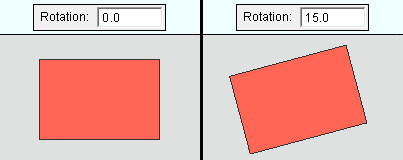
|
An elevation view of rotated plates. |
Setback: The distance (in the primary dimension " Units " or other units ) by which the supported or supporting panel embed is set back from the supported panel embed. This applies if the " Embed type " is ' Plate '. Otherwise, this field will be disabled ( grayed out ). If the " Panel end setback " has a non-zero entry, that distance is added to the ' Setback ' when the plate is added.
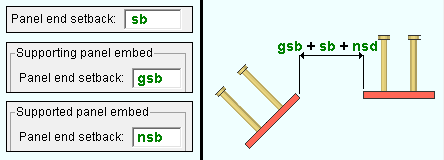
|
A plan view showing the effect of a positive " Panel end setback " on the position of the supported and supporting panel embeds. |
Length: The length (in the primary dimension " Units " or other units ) of the angle or channel. This applies if the " Embed type " is ' Angle/Channel '. Otherwise, this field will be disabled ( grayed out ).
Long leg vertical: ![]() or
or ![]() . This applies if the " Embed type " is ' Angle/Channel '. Otherwise, this field will be disabled ( grayed out ).
. This applies if the " Embed type " is ' Angle/Channel '. Otherwise, this field will be disabled ( grayed out ).
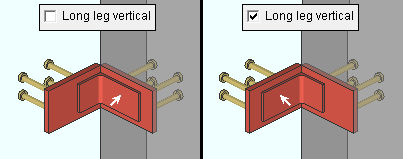
|
If this box is checked (
), the long leg of the angle extends perpendicular from the embed.
If the box is not checked (
), the long leg of the angle is aligned with the embed.
concrete | the concrete command group in modeling | top
To manage panel-to-panel embed assemblies :


"Load ..." opens the Select Assembly to Load window, from which you can select previously saved panel-to-panel embed assemblies and add them to tilt-up panels.
"Save ..." opens the Save As... window, in which you can enter a name and press ' OK ' to save the embed assembly for later use. Then, you can " Load... " the embed assembly with this tool or with the Add Embed Assembly tool.
"Delete ..." removes the embed assembly from the Select Assembly to Load window.
concrete | the concrete command group in modeling | top
To close the Add Panel-to-Panel Embed Assembly widow :


"OK" closes this window and completes the edit operation.
"Cancel" (or the Esc key or the
button) closes this window without saving changes you have made.
"Reset ..." undoes all changes made to this window since you first opened it. The window remains open.







